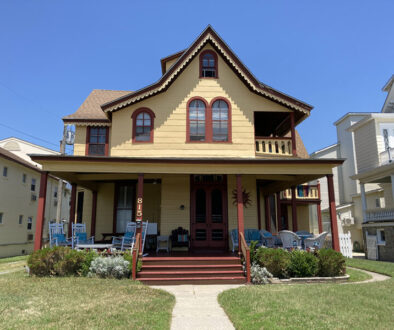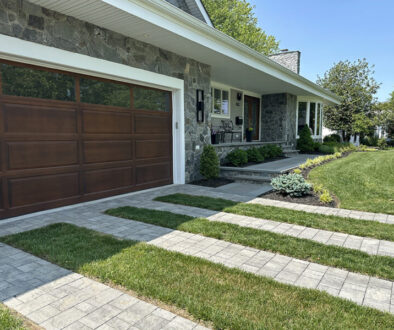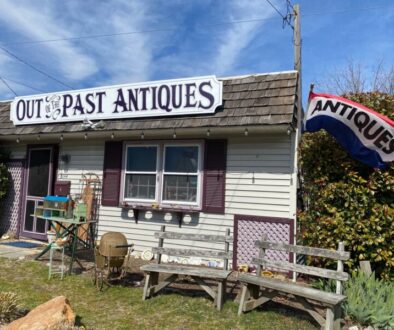Order on the Court

Despite whatever misgivings you may have about taking to the tennis court — age, lack of physical prowess, hatred of dripping sweat under the gaze of the summer sun — Cyril “Cy” Cummings, club manager of the Historic William J. Moore Cape May Tennis Center, pretty much dares you to pick up a racket.
“You get on the court with me, and I guarantee you, I don’t care how klutzy you are, in literally five minutes, I’ll have you hitting many, many tennis balls,” says Cummings. “I say that to hundreds and hundreds of people throughout the year.”
Cummings, who has been with the Cape May Tennis Center since 1998, is the perfect man for the job. As manager, he’s part encourager, part scheduler, all-the-time courts facilitator and spokesman for the facility. But more than that, he really loves tennis.
“One of the best things about tennis is that it’s a game for life,” says Cummings. “Anybody can play at any age. I can play with somebody older than me, I can play with somebody younger than me. I can play with kids. I can play all different levels of the game. It’s an amazing sport when you get into it — you can play forever. I’m 74 and I’m still playing, I just got off the court. I’m down in Del Ray (Florida) and I just got done playing with a guy from Cape May, believe it or not.”

Cummings himself didn’t take up tennis until his mid-thirties, when he began learning and then eventually, teaching. “We still smoked,” joked Heidi Cummings, Cy’s wife, who learned alongside him.
He doesn’t teach much these days — he leaves that to pros Joe Halasz, Lionel Desroisers, Matt Gilbert, and Zee Vlahovic. Among the four of them, their expertise ranges from being a tennis pro in Serbia; a 2010 Atlantic City Press Coach of the Year; an inductee into the NJ Interscholastic Coaching Hall of Fame; and a coach of USTA ranked 3.5-4.0 tennis teams in New York City, with certifications that include USPTA and PTR. The resident pros provide private and small group tennis lessons and run youth clinics and programs.
Cummings oversees the courts, making sure every member has a chance to play and that everyone has someone to play with or against. With 16 courts open year-round, it’s quite the responsibility.
“Part of my job is to make sure people get a chance to play,” says Cummings. “If you’re a brand- new member, you’ve never played before, what I would suggest is you take a couple of lessons to get used to how to play — and everybody that starts playing tennis, every single one always improves. I’ve never seen anybody not improve after you start hitting tennis balls — and then my job is to find out what level you’re playing at and I will find you game. I tell many people, if I can’t get you games, I’ll give you your money back on your membership. I’m that confident I can get people to play.”
Membership at The Cape May Tennis Center isn’t prohibitively expensive. With an annual fee of $385 for a yearly membership and options for weekly and winter memberships — as opposed to paying the $15 for an hour and a half in the morning, and $12 in the afternoon non-member fees — it’s an especially good deal if you like to play a lot of tennis. (Those 21 and under play free from noon to 4pm daily) But it’s more than just a good value. At Cape May Tennis Center, you’re paying for the community.
“There’s usually four people per court, 16 courts, three times a day. We’re going through lots and lots of people throughout the season,” says Cummings. “Thousands and thousands go through. I let my members call the day before to reserve a court and give non-members what’s available. We start playing at 7am. Tennis players are extremely routine, and always want to play in the morning.”
Though a good number of those are vacationers just looking for a match while they’re enjoying a week at the beach, quite a few others — approximately 370 — are members. As such, they become regulars, meet one another, and gravitate to others at their tennis level.
“There are a whole bunch of different little groups that play. You gravitate towards your own level of play,” says Cummings. “So there’s several different levels of play and usually you end up with a group and then next thing you know, you’ll say, ‘Hey Judy, can you play next Thursday?’ It’s that type of camaraderie so you always have games…there are social tournaments throughout the season. It’s a fun club.”
In addition to joining for the obvious benefits —14 Har-Tru and two hard courts, year-round play, pros and a pro shop onsite, a clubhouse with restrooms, showers and a kitchen, there are a variety of tournaments. These include Mixed Doubles Round Robin, Laura White Ladies Doubles Tournament, White & Wood Mixed Doubles and Parent/Grandparent-Child Doubles Tournament. Finally, playing at Historic William J. Moore Cape May Tennis Center means being a living part of history.
The legacy of William J. Moore
We’d be remiss if we jumped into the logistical details and history of the Cape May Tennis Center without first mentioning its honoree, William J. Moore, the first black tennis pro in America.
William J. Moore was born in 1872 in West Chester, Pennsylvania as the son of emancipated slaves. According to his obituary, which was published in The New York Times, Moore graduated from Howard University — where in 1967, he was honored as their oldest living graduate — before moving to Cape May. He founded and became principal of Cape May Colored School in West Cape May in 1895, near where the present-day West Cape May Elementary School—at 301 Moore Street. Moore spent 54 years teaching there before it was closed in 1948 when segregated schools were outlawed — and in fact, it wouldn’t seem inappropriate for a school or place of higher education to carry his name instead of a tennis center. However, it would be the sport of tennis that propelled him to even greater heights.

Like Cummings, Moore didn’t start playing tennis until he was in his 30s. At the time, he was working at the Cape May Golf Club during the summers — much like today, a teacher’s salary wasn’t enough to put nine kids through college — where he was put in charge of their new tennis courts. Instead of fumbling through a newly learned sport, Moore perfected his technique, traveling and observing the game being played throughout the country and studying court composition. He became an expert, and even published a manual that is, according to the Tennis Center website, still recognized as a major contribution to teaching the game — Teaching Tennis to Beginners. As such, he received awards — for “loyal and meritorious service to tennis” from the Middle States Lawn Tennis Association in 1969 — but perhaps more important, he gained a reputation. Already a skilled teacher, William J. Moore became the tennis coach everyone wanted to teach their children.
“I knew Mr. Moore as I spent summers in West Cape May, and my brother took tennis lessons from him,” says Dr. John Francis, president of the William J. Moore Scholarship Foundation. “He was a tennis pro when there were few black tennis players. He was one of a kind and helped establish the tennis courts in Cape May City. So, he should be remembered for tennis. I remember him as an educator who empowered his students to excel, and most importantly, he was kind.”
Though he started off primarily teaching tennis to children, it wasn’t long before Moore began teaching all levels. His expertise and friendship with a retired DuPont executive, Thomas W. Harris, led to the development of the Cape May Tennis Center, where William Moore was designated the “official pro.”
The History of Cape May Tennis Center
According to the Historic William J. Moore Cape May Tennis Center website, the idea of a tennis center can be dated back to 1961 and Moore’s friend, Tom Harris and his wife, along with Dr. and Mrs. Sidney Newcomer (who owned and were living in the Physick house at the time) and Robert C. Alexander who donated almost two acres to the City of Cape May, with the stipulation that it was earmarked for all things tennis related. In 1962, construction on the project began, “financed by private contributions,” and by June, the first court was ready for play.
That first summer, the center consisted of five tennis courts, and was managed by 90-year-old William J. Moore. Moore’s son Ossie assisted and succeeded his father as pro until his death in 1983. But before that, in 1972, Moore celebrated his 100th birthday at the courts, which were renamed and dedicated to him as the “William J. Moore Tennis Center.”


Moore almost couldn’t attend the festivities. A few days prior to his birthday, he fell on the courts and sustained an injury. With a broken hip, it was evident that Moore couldn’t attend the event as planned — but he wasn’t going to miss it. Instead, Moore was carried to the festivities honoring his 100th birthday on a stretcher.
William J. Moore died a year later, in 1973, but he leaves a living and breathing legacy behind. The tennis center is active and thriving, with visitors coming year after year to enjoy, to compete, and to play on Moore’s courts. And though he passed away five decades ago, Moore himself isn’t forgotten. Nor is his family.
“I learned to play tennis in Cape May,” says Cummings. “I took my first lessons from Ossie Moore, William J. Moore’s son. It’s easy if you just watch the ball.”



